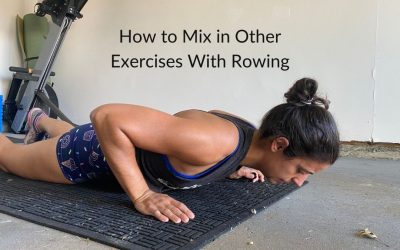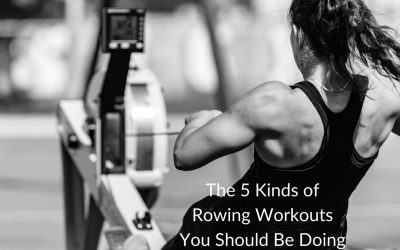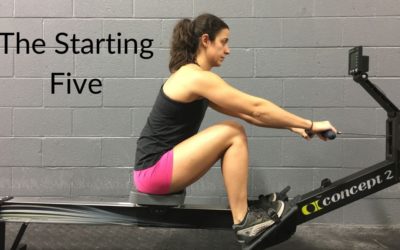Beginner Basics of Heart Rate Training in Rowing
You may read heart rate training and think you need to start paying attention to all these numbers or buy all of the things to track your heart rate. While you can buy some gear to help you accomplish heart rate training, it’s not required. Sure, the gadgets will help you be more accurate, but there are ways to judge what zone you’re in that doesn’t require fancy toys.
If you’re wanting to get into those numbers, I’ll have some of that for you. For others that don’t care for the numbers, there’s some of that too. Depending on your sport or your coach, some may find these percentages can vary. This is an overall guide to help beginners start to understand heart rate training. If you’re looking for heart rate training for a specific goal, hire a coach. Now let’s get into it.
*disclaimer, only go for those higher zones if you’ve been approved to do so medically
MAX HEART RATE
The first thing you’ll want to figure out is your max heart rate. Now, you don’t need to go do a max heart rate test. I wouldn’t suggest doing that without being supervised.
One method is to use the formula 220 – your age. So, a 40 yr old will have an estimated maximum heart rate of 180 bpm. This isn’t entirely accurate, but for the most part, works well. If you do end up using a heart rate monitor and find yourself hitting higher heart rates while sprinting, you can use the highest bpm recorded as your max heart rate.
Once you have your maximum heart rate, you can start calculating the individual zones.
ZONE 1 – Slow steady-state
The lowest zone operates between 50-60% of your maximum heart rate. In this zone, any type of activity will seem pretty easy and something you may not even realize is activity. Things like walking, or paddling with little to no pressure will be in this zone.
This zone can also be used for recovery. This is very light pressure, keeping good form, and working on drills.
ZONE 2 – Moderate steady-state
The next zone up is when you start adding more pressure into your drive. Zone 2 operates at 60-70% of your maximum heart rate. At this heart rate, you should be able to sustain this level of intensity for quite a while (longer than 30 minutes).
This is where your moderate steady-state pieces fall. Steady-state means that you are holding the same split and rate over and over again. When you’re just starting out, most of your workouts will be in Zone 2 as you get the feel for rowing. This zone is great for improving your base fitness level.
ZONE 3 – Intense steady-state
As you’re working on going harder in your steady-state pieces, you’ll start to fall into Zone 3. This zone operates at 70-80% of your maximum heart rate. At this point, the longer pieces will feel a little more difficult, but it won’t take too long to recover in between pieces. You may have to start cutting longer pieces up and taking short breaks before going again compared to being in Zone 2.
ZONE 4 – Anaerobic threshold
Zone 4 operates at 80-90% of your maximum heart rate. This is where pieces are going to feel tough, and it will be hard to sustain pieces longer than 10 minutes in this Zone. You’ll be breathing pretty hard, but you’re not sprinting or going all out.
This zone is called the anaerobic threshold because of the switch your body goes through from aerobic to anaerobic. To put it simply, when you’re in your aerobic zone, your body is using oxygen. When you’re anaerobic, the body isn’t able to keep up using oxygen and starts using stored sugars.
Somewhere in this percentage range, your body will switch from aerobic to anaerobic. As you get more fit, it will take longer to cross that threshold. For more on the anaerobic threshold, feel free to visit this page on the Concept2 website.
ZONE 5 – Sprints
This last zone, Zone 5, operates at 90-100% of your max heart rate. This range is typically reserved for your shorter sprint pieces that are 4 minutes long and less. Anything longer than that will most likely have you closer to the top of your Zone 4 heart rate.
When you’re in Zone 5, you’ll know it. Everything hurts and you can’t wait to be done!
Here’s a summary of those zones for a 40 yr old:
Max Heart Rate: 220-40 = 180 bpm
Zone 1: 90-108 bpm
Zone 2: 108 – 126 bpm
Zone 3: 126 – 144 bpm
Zone 4: 144 – 162 bpm
Zone 5: 162 – 180 bpm
TALKING TEST
If you don’t have fancy equipment to take your heart rate to know exactly where you are, there’s another way to determine what zone you’re in. It’s called the talking test. Even if you don’t work out with a buddy, you can use this test to see how you’re feeling and where you fall. If you’re by yourself, you can talk to yourself or speak out song lyrics if you don’t know what to say.
For Zones 1 and 2 you’ll be able to hold a conversation. Zone 2 will be where there’s more effort than a walking pace, but you’re still able to hold that conversation.
When you’re in Zone 3, you’ll still be able to talk, but it may only be a couple of words here and there. Your sentences will be short and concise.
Once you get to Zone 4, you won’t want to talk at all. If you need to talk, it will be one or two words tops.
And there’s no way you’d be able to talk when you’re in Zone 5. You’re most likely going hard enough that you can’t process words until you’re done.
WARMING UP
Depending on what zone you plan to do your workout in will change how you want to warm up. Higher zones need longer warm-ups. This is so your muscles can be properly warmed up to do the work they are going to do. These warm-up periods should be mostly rowing, but can also incorporate some active stretching and loosening up.
Zone 1 is reserved for recovery between pieces, and it’s generally not used in a workout since we get to this zone by walking and doing day-to-day tasks.
For Zone 2, the warm-up can be fairly short, around 5-8 minutes. This warm-up can be at the same pace or a little slower than the workout goal pace.
Zone 3 needs a little bit longer warm-up, somewhere between 10-12 minutes. You may incorporate your warm-up in your first longer piece if you are doing something like a 10k. If it’s a longer piece for time in this zone, then do the warm-up separately.
Zone 4 has us reaching that anaerobic threshold, so the warm-up should be between 12-15 minutes. It’s ideal to do a couple of sets of 10 strokes at the goal pace, getting used to that pace you’re trying to hit.
Zone 5 has us doing some pretty hard pieces, so we want our warm-up to be between 15-20 minutes. It’s very important to do some power 10s at that goal pace to get ready for it. It can be dangerous if you’re not warmed up enough and try to jump into this zone.
As for a cooldown, it’s ideal that the cooldown is about the same length of time as the warm-up. This will help you recover well before your next workout.
USING HEART RATE IN TRAINING
When you’re at the beginning of your fitness journey, most of your workouts will start in Zone 2. As you get more confident and find more power in your rowing stroke, you may find that your longer workouts will be in Zone 3.
You may only be able to row for a couple of minutes at a time when just starting out. That’s completely normal. Rowing is hard! Try to keep that heart rate in Zone 2 or 3 as you build up the amount of time you’re able to row. If you find that it’s hard to stay in these zones and your heart rate continues to rise, try rowing at a lower stroke rate (18-22 strokes per minute).
As you keep rowing, you’ll find that it will start to get easier to stay in Zone 3 for longer. Once you’ve built a decent base with most of your steady-state pieces being in Zone 3, you can start working to improve your Zone 4 work. These pieces will be shorter, around 5-10 minutes long. Once you’re in this zone, you’ll want to have anywhere from 2-4 minutes of rest in between pieces to let your heart rate come down.
On that note, if you’re looking for a way to see if you’re improving, one way to do that is to keep track of how long it takes your heart rate to go down in between pieces and after the workout is done. The more fit you are, the faster it will come down. Other things can play into this as well like adequate sleep and eating enough, so don’t think you have to measure this to know you’re improving. Getting faster and being able to hold better splits will also show you that you’re improving.
Once you get into the Zone 5 work, it’s going to feel very tough at first. These will be shorter pieces, less than 4 minutes long, where you feel spent afterward. Your body isn’t used to going this hard. Some may find it easy to get their heart rate this high, and some may find it difficult. Don’t overthink it. Do your best in the workout you have.
Now that you are working in all of the zones, you’ll want your workouts to vary in frequency, duration, and intensity. What I mean is, don’t have all of your workouts in Zone 3, or all of them in Zone 5. If you work out 3 times a week, I would do one in Zone 3, one in Zone 4, and one in Zone 5. If you work out more than 3 times a week, you can add in the Zones that support your goal. Going for a half or full marathon? Do some more Zone 3 work. Got a 2k race coming? Do more Zone 4 and 5 work. Workouts in higher zones will be shorter, and workouts in lower zones can be longer.
If you’re still a little bit confused, that’s ok. Attempting to incorporate heart rate training into your workouts can feel overwhelming. If you’re still not sure, find a coach that you trust to work with who has the knowledge to incorporate this into your training.
How to Mix in Other Exercises With Rowing
Many people can be satisfied with workouts that only involve rowing on the rowing machine. However, even I can admit that can get boring after a while. If you’re going to start mixing in other movements, it’s good to keep a couple of things in mind. I need to throw...
The 5 Kinds of Rowing Workouts You Should Be Doing
It’s easy to get sick of the same old, same old workouts week after week. Looking to mix it up? Here are the 5 different kinds of rowing workouts you should be doing. ROUNDS FOR TIME This is an easy format to start mixing in other movements. These can be bodyweight...
The Starting Five
One of the easiest ways to improve upon a score for a workout is to make sure you’re starting it off right. It’s easy to slowly build into the piece, but those splits in those first strokes will greatly affect your average. It’s worth it to start out strong so that...



